Flag of the Romani people
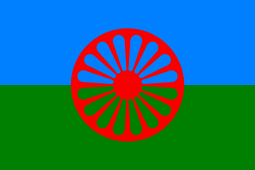 | |
| Names | O styago le romengo, O romanko flako |
|---|---|
| Use | Ethnic flag |
| Adopted | 1971 1978 |
| Designed by | Gheorghe A. Lăzăreanu-Lăzurică (purported) World Romani Congress Weer Rajendra Rishi |
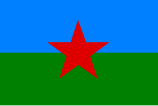 Variant flag of Flag of the Romani people | |
The Romani flag or flag of the Roma (Romani: O styago le romengo, or O romanko flako) is the international flag of the Romani people. It was approved by the representatives of various Romani communities at the first and second World Romani Congresses (WRC), in 1971 and 1978. The flag consists of a background of blue and green, representing the heavens and earth, respectively; it also contains a 16-spoke red dharmachakra, or cartwheel, in the center. The latter element stands for the itinerant tradition of the Romani people and is also an homage to the flag of India, added to the flag by scholar Weer Rajendra Rishi. It superseded a number of tribal emblems and banners, several of which evoked claims of Romani descent from the Ancient Egyptians.
The 1971 flag claimed to revive a plain blue-green bicolor, reportedly created by activist Gheorghe A. Lăzăreanu-Lăzurică in interwar Greater Romania. This design had been endorsed in the 1950s by Ionel Rotaru, who also claimed it as a flag for an independent settlement area, or "Romanestan". A tricolor version, flown by survivors of the Romani genocide, fell out of use due to allegations that it stood for communism. Rishi's definitive variant of 1978, with the added wheel, gained in popularity over the late 20th century; it is especially associated with groups advocating transnational unity of the Romani people and combating its designation as "Gypsies". The flag was promoted by actor Yul Brynner and violinist Yehudi Menuhin, and also adopted by Florin Cioabă, self-proclaimed "King of the Roma". This design was especially popular in Socialist Yugoslavia, which awarded it official recognition upon adoption.
The WRC Congress never provided specifications for the flag, which exists in various versions and has many derivatives, including national flags defaced with Rishi's dharmachakra. Several countries and communities have recognized it officially during the 2010s, but its display has also sparked controversy in various parts of the European Union. Derivatives also became widely used in Romani political symbolism during the same period. However, inside the scholarly community, the Romani flag has been criticized as Eurocentric, and its display as a perfunctory solution to issues facing the ethnic group it represents. It has been continuously rejected by various Romani tribes, as well as by the Ashkali and Balkan Egyptians, who form a distinct ethnicity.
Origins[]
Several 15th-century sources report the existence of heraldic symbols associated with nomadic "Gypsy Princes" from the Holy Roman Empire. One such figure, named Panuel, used a crowned golden eagle, while another one, Bautma, had a complex coat of arms, incorporating a scimitar; both figures also used hounds as their heraldic animal, with Panuel's being a badge.[1] A 1498 epitaph at Pforzheim commemorates a Freigraf of "Little Egypt", in fact a Romani tribal leader. His attached coat of arms has the star and crescent in combination with the stag.[2] Other early Romani symbols include a red banner carried by Turkish Romanies, organized as an esnaf (guild) of the Ottoman Empire.[3] A banner of the Kosovar Gypsies, dating from 1849, is still preserved in Prizren.[4] Guild organization was also maintained in the post-Ottoman Principality of Bulgaria—an association of Bulgarian Romani porters was set up in 1901; its flag is also preserved.[5] In 1910, Vidin became home to the first-ever civic organization for Romanies (still describing themselves as the "Egyptian Nation" or "Copts"). It showed Saint George slaying a crocodile, which, the group explained, was symbolic of Christianity vanquishing Egyptian paganism.[6]
According to historian Ian Hancock, the current flag originates with the world Romani flag proposed in late 1933 by Romania's General Union of the Romanies (UGRR), upon the initiative of Gheorghe A. Lăzăreanu-Lăzurică; the chakra was absent from that version, which was a plain bicolor. Scholar Ilona Klímová-Alexander argues that such a detail is "not confirmed by the statutes or any other source."[7] Other historians, including Elena Marushiakova, note the "lack of any real historical evidence" to substantiate Hancock's account, which they describe as a sample of "nation-building" mythology.[8] Sociologist Jean-Pierre Liégeois also describes the UGRR's Romani flag as a theorized concept, rather than an actual design,[9] whereas scholar Whitney Smith believes that the bicolor existed, but also that its designer remains unknown.[10] Lăzurică's own organization had another, better attested, flag, used to represent Romania's Romani community. It was described in the UGRR charter as a defaced flag of Romania, or "the Romanian national colors".[11] Its symbolism combined the national coat of arms with symbols of Romani tribes: "a violin, an anvil, a compass and a trowel crossed with a hammer."[12] The UGRR also used at least 36 regional flags, which were usually blessed in public ceremonies by representatives of the Romanian Orthodox Church, to which Lăzurică belonged.[13]
In neighboring Poland, a Kalderash man, , established himself as a "Kings of the Gypsies", indifferent to Lăzurică's projects. A February 1935 report mentions various "Gypsy banners", as well as a sash and an "official seal", appearing at a ceremony in which Kwiek became "Leader of the Gypsy Nation".[14] One account suggests that King Matejasz's arms showed a Pharaoh's crown alongside three symbols of the Romanies' "wandering life": a hammer, anvil and whip.[15] The king's funeral in 1937 saw the flying of various blue and red banners, with slogans espousing Kwiek's loyalty toward Polish nationalism.[16] One report in the Journal des Débats describes the procession as carrying an ethnic flag "with the Kwiek dynastic emblem", alongside the flag of Poland.[17] Following the ascension of to the throne in Warsaw, journalists noted that the "Gypsy kingdom" was not yet flying a single flag of its own, and that "banners of various colors" were used.[18] Regional symbols also prevailed in the Kingdom of Bulgaria. An Egypt society, founded by left-wing Romanies and functioning as a branch of the Bulgarian Communist Party from 1920, used a "wine-red flag"; a decade later, "Mohammedan" Romanies prioritized the star and crescent as symbols of Islam.[19] In the Kingdom of Yugoslavia, Romanies united around the cult of Saint Sarah as Bibija used a blue banner displaying Sarah and Saint Nicholas together.[20] The Panhellenic Cultural Association of the Greek Gypsies, active under the Metaxas Regime, used a flag of unspecified color, adorned with the image of Saint Sophia.[21]
By the mid 1930s, the initiative to use and recognize an international flag was taken up by the UGRR's new president, Gheorghe Nicolescu;[22] at the time, he corresponded with Kwiek's rival King, Mikita, who wished to set up a Romani state on the Ganges, or in Africa.[23] According to one report, the 1935 Romani congress in Bucharest, presided upon by Nicolescu, had the "Romany flag" displayed alongside portraits of Adolf Hitler and Michael I of Romania.[24] By 1937, Nicolescu's admiration for Nazism and for the National Christian Party also resulted in the usage of swastikas.[25] Despite such "alliances of Roma activists with leading political forces",[26] the 1933 international flag, if ever used at that stage, virtually disappeared by the time of World War II;[10] many European tribes were decimated in the Romani genocide, itself part of the Holocaust. This period also saw many Romanies going into hiding or denying their identity to escape the Einsatzgruppen or deportation. In one incident reported at Simferopol in 1941, Crimean Romanies flew the green flag of Islam, hoping to persuade the Nazis that they were Tatars or Turks.[27]
Early into the Cold War era, ethnic symbolism experienced a resurgence. Žarko Jovanović, a survivor of Jasenovac concentration camp, recorded the Holocaust experience in various songs. One of these, Jeg djesoro ratvalo avilo ("A Day Turned Bloody"), refers to the "Gypsy flag" (o romanko flako) being hoisted in honor of Romani continuity.[28] Active in 1945–1948, the United Gypsy Organization in Bulgaria used a "red [flag] with two white fields and with a triangle in the middle."[29] A rival Bulgarian Romani body, called Ekipe, mentioned both the Romani state and the Romani national flag in its charter, though it failed to describe the latter in sufficient detail.[30] In 1946, Kwiek, having survived in Holocaust in hiding, returned to regular life in the Polish People's Republic. He renounced his claim to the Romani throne, as well as his itinerant lifestyle, and asked instead to be recognized as "President".[31]
From 1955, a "flag of the Gypsies" represents Romani pilgrims to the Sanctuary of Our Lady of Lourdes. It is described as a sixteen-ray comet on a field of starry blue with the effigies of Christ and the Virgin Mary.[32] The item is explained in more detail as a "grand flag of the night, carrying the Star of the Magi."[33] Meanwhile, the bicolor flag surfaced, or was reused, in France by . A Romanian Romani refugee and former sailor, he envisaged the creation of a Romani state, now called "Romanestan", and showed its flag to journalist Nico Rost.[34] Several accounts suggest that he originally obtained recognition as "Voivode" by 75,000 Romanies at Ankara, in December 1958.[35] On May 24, 1959, he crowned himself at Enghien-les-Bains as "Vaïda Voëvod III", Supreme Leader of the Ursari tribe (though explicitly not as the "King of the Gypsies"), and formed a nucleus of the International Romani Union.[36] The bicolor appeared in his sash, presented to him alongside a sword and a necklace.[37] His charter suggested that green stood for "land covered in vegetation" and a "world without borders", with blue as a stand-in for "cosmos and liberty". Unusually, the horizontal display was explained in relation to the vertical flagpole, which represented "the line of profundity of our thinking"; the adoption of a heraldic device was announced, but postponed for "when the time comes."[10]
By 1961, Rotaru openly claimed the bicolor as the state flag of Romanestan; in this context, the blue was explained as representing freedom.[10] The location for the proposed state shifted constantly, from Somalia or a "small desert island" to an area around Lyon.[38] The project was registered with alarm by French intelligence, who kept Rotaru under watch as a possible communist infiltrator serving the Eastern bloc. Its agents also believed that Vaïda was not the same as Rotaru, but rather a figurehead.[39] The Somalian relocation plan was received with distress by many of Rotaru's nominal subjects, who feared that various nation-states would endorse it unilaterally, using it is an excuse to expel the Romanies from Europe.[40]
Lăzurică and Vaïda's flag faced competition from a green-red-blue horizontal triband, which stripes respectively representing the grass, fire, and the skies. By 1962, it had become highly popular among Romani communities.[41] During that interval, references to this symbolism were promoted by Francoist Spain as "less contentious" than left-wing symbolism favored by local Romanies. A reference to the "Republican flag", in La Niña de los Peines' Triana, was changed by censorship to read "Gypsy flags" (banderitas gitanas).[42] Suspicions that the tricolor's prominently displayed red stood for communism led some activists to promote a green-blue bicolor with a red flame or wheel instead of the stripe.[41] An alternative flag of Romanestan was being proposed in 1966 by a Turkish Rom, Nazım Taşkent—it showed violins, guitars and drums on a pink background.[43] Three years later, Romanies gathering at Banneux in Wallonia had a multitude of flags, in various colors, some of them displaying images of Our Lady of the Poor, alongside caravans.[44]
- Evolution of the Romani flag

Variant reportedly advanced by the UGRR ca. 1933
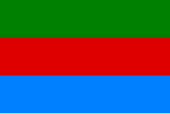
Triband version (1960s)
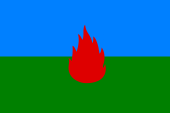
Variant with flame (1960s)
Early use[]
Around 1970, Rotaru was issuing Romani "identity cards" which were decked in blue and green.[45] In the late 1960s, an "International Gypsy Committee", presided upon by , validated continued usage of the bicolor. The group also announced in 1968 that it would institute a Blue Green Literary Award, named in honor of the flag; activist Leuléa Rouda explained that these were the "colors of the Gypsy flag", "colors of liberty and hope, of sky and nature".[46] The following year, Rotaru's Comité International Tsigane attended a reunion of the Council of Europe in Strasbourg. Delegates carried with them a "Gypsy flag" of blue and green, though their version broke with earlier banners, in being "divided not horizontally but diagonally".[47]
A red-wheel variant was eventually selected as the standardized design, as recognized by the World Romani Congress (WRC). Reportedly, the bicolor background was specifically proposed by Jan Cibula, who established its pedigree as originating with "the pre-war Bucharest congress."[48] The original WRC congress of 1971, held at Orpington, only confirmed the bicolor, though specifying that a "red fire", "thin stripe", or "wheel" could also be added. This was a compromise version to appease Slobodan Berberski and other communist delegates, who had campaigned for the addition of a red star.[49] The work in its definitive form is attributed to an Indian Romologist, Weer Rajendra Rishi.[50] Specifications were also adopted at subsequent WRC meetings, especially during the second congress of 1978.[51] The wheel was not only made a permanent feature of the flag, but was also explicitly based on the Ashoka Chakra, as used in the flag of India.[52] The decision to include "something Indian" on the flag was generally popular, reflecting in part Rishi's theories, according to which Romanies were a "medieval warrior caste" akin to Rajputs.[53] Reportedly, this variant defeated proposals by other attendees, who supported "earlier flags which had depicted an icon of a horse". Several activists were upset by Rishi's intervention, feeling that the chakra was an outside symbol, and as such one "thrust upon them".[54] As noted by Smith, the international flag did not detail specifications such as designs or Pantone values. The original WRC design described a "carriage wheel" which did not closely resemble the chakra; chakra-like designs are therefore more recent.[10] Painter Michel Van Hamme, who claims to have contributed in constructing the wheel flag, notes that the sixteen spokes stood for 16 centuries of nomadism.[55]
According to sociologist Lídia Balogh, the Romani flag retained Indian symbolism, but was still readable without it: "The wheel can also refer to the eternal cycle of the world, or it can be interpreted as a carriage wheel".[56] One complex explanation of the resulting composition is favored by the Romanies of Brazil. According to these sources, the upper blue half represents heavens, as well as "liberty and peace", as "fundamental Gypsy values"; the green is a reference to "nature and routes explored by the caravans". The red wheel is "life, continuity and tradition, the road traveled and still ahead", with the spokes evoking "fire, transformation, and constant movement."[57] According to ethnologist Ion Duminică, it stands for the "Road of Life", with red as an allusion to the "vitality of blood." Duminică also explains the blue as a reference to "Heavens-Father-God" and to the ideals of "liberty and cleanliness, the unbound space"; whereas green is a stand-in for "Mother Earth".[58] Balogh also notes that the two stripes can be deciphered "without any particular cultural background knowledge" as being the sky, implicitly a symbol of "freedom and transcendence", and the earth; she views the red as a reference to blood, with its dual meaning: "blood is the symbol of life, on the one hand, and the blood spilled on wars and destruction."[59]
As sociologist Oana Marcu argues, the reference to "perpetual movement" signified that the Romanies were proudly accepting their nomadic traditions, previously seen as "socially dangerous".[60] According to Balogh, the wheel recalls ancient nomadism, but also the Romanies' participation in the 21st-century economic migration across Europe.[61] Similarly, Duminică writes about symbols of nomadic life as evoking prosperity, since "with no opportunity to perambulate, Romanies will fall prey to poverty."[62] Activist Juan de Dios Ramírez Heredia explained it as a "cartwheel standing in for freedom, which is characteristic of our culture."[63] However, in order to honor the "continuous and varied" support it had received from Socialist Yugoslavia, the WRC also accepted Berberski's star on unofficial variants, specifically referencing the Yugoslav flag.[64]

Yugoslavia also pioneered the official Romani flag, which was given recognition in the constituent Socialist Republic of Macedonia as early as 1971 (or 1972).[10] This was the culmination of efforts by , a Macedonian Rom.[65] The symbol was especially important for the Gurbeti around Skopje, who integrated it within wedding ceremonies,[66] and was also popularized on album covers by Žarko Jovanović.[67] During the Catholic Jubilee of 1975, Manushes gathered at Primavalle under a "blue banner, with the crowned figure of Our Lady of the Gypsies and a caravan, topped by a tiny tricolor pennant."[68] By then, the WRC variant was also used for remembering the 1940s genocide, beginning with a ceremony held at Natzweiler-Struthof in June 1973.[69] In this commemorative context, however, it could be replaced by other symbols: in April 1975, Romani Holocaust survivors were represented at Fort Mont-Valérien by a never-before-seen banner, displaying a plum[70] or violet[71] triangle on white. This was a visual clue to Nazi concentration camp badges, and, according to journalist Jean-Pierre Quélin, was picked and designed by a Manush politician, Dany Peto-Manso, and carried on the field despite deprecatory remarks from members of the National Gendarmerie.[71] Peto-Manso himself referred to flag as "hastily made", without specifying its author.[70]
The WRC flag was given more exposure in 1979, when a Romani delegation comprising Hancock and Yul Brynner presented it to the United Nations.[72] A "small organized group of Gypsies, with a flag and armbands", took part in the August 1980 pilgrimage to the Black Madonna of Częstochowa, in what was then the Polish People's Republic.[73] Within the post-WRC setting, it remained especially important as a distinguishing symbol of NGOs who prefer the terms "Roma" and "Romani" over exonyms such as "Gypsies"; an example of this is the Roma Community Center in Toronto.[74]
Spread and controversy[]
The Romani flag acquired an enhanced political status during the late stages of the Cold War. This was especially the case among Hungarian Romanies, who embraced cultural separatism. In the years leading up to the creation of a Gypsy Minority Self-Government, activists made a show of removing Hungarian flags from public meetings, which were held under all-Romani flags.[75] The WRC flag was flown during the Velvet Revolution in the Czechoslovak Socialist Republic, in particular at a rally of Romani anti-communists, held outside Letná Park.[76] Following the dissolution of Czechoslovakia, Slovak Romanies adopted the WRC design with the wheel in yellow, combined with the Slovak tricolor.[10] From about 1989, Croatian Romanies, represented by the "Democratic Party of the Croatian Roma", have used a variant of the chakra flag superimposed with the šahovnica.[77]
In July 1992, a casket containing the body of Camarón de la Isla, Spain's influential Rom singer, was draped with a purported "Gypsy flag". This showed a cartwheel and a map of Catalonia, both on a field of plain green.[78] Later Catalan variants are more closely modeled on the 1978 flag, but have the red wheel outlined in yellow, perhaps to evoke the Senyera.[10] A chakra-like derivative, or "round-wheeled Gypsy flag", also appears, along with the menorah, in the arms granted to Jewish violinist Yehudi Menuhin upon his creation as a British lord 1993; according to music critic Mark Swed, they are defiant symbols of Menuhin's nonconformity.[79]

The flag was fully integrated in Holocaust memorials by 1995, when it was shown at Auschwitz-Birkenau Memorial and Museum.[10] After 2000, the WRC bicolor also acquired recognition from other national and regional governments. In 2006, as part of an effort to combat racism in Brazil, President Luiz Inácio Lula da Silva instituted a "National Day of the Gypsy" (May 24), during which the Romani flag was on display in official settings.[80] The Romani community of Spain was similarly honored at various dates in 2018, when the Romani flag was displayed by for instance by the City Council of Madrid[81] and its correspondent in Alicante.[82] In October 2011, a similar initiative in the Welsh town of Aberystwyth resulted in controversy, after a local councilor had argued that the expenses were unjustified.[83]
Since the 1990s, chakras and cartwheels have endured as major preferred symbols of Romani activism in Europe, being adopted by organizations such as Romani CRISS, the Social Political Movement of the Roma, and the Museum of Romani Culture.[84] The traditionally Romani Šuto Orizari Municipality, in North Macedonia, has a "a colourful flag featuring the Roma wheel – an Indian chakra, which refers to the origin of the Roma people."[85] Eight-spoked wheels are also popular as variations, used for instance by the Ciocănari Romanies of Moldova.[86] In 2002, the Italian Rom artist Luca Vitone designed an anarchist version of the flag, featuring the red chakra on a field of black.[87] By 2009, other derivatives of the Romani flag were becoming widely used by self-identified Manush or "Traveller" users of Facebook, sometimes combined with badges showing hedgehogs and images of caravans.[88] A controversy erupted in Prague during July 2013, when artist Tomáš Rafa displayed hybrid versions of the Romani and Czech flags. This commentary on the marginalization of Czech Romanies was read as a defamation of the national symbols, and resulted in Rafa being fined.[89]
A 2009 study among Hungarian Romanies showed that many were recognizing the flag as standing in for the Romani nation as a whole.[90] In subsequent years, it appeared during Romani Catholic pilgrimages to Pomezia, which commemorate Pope Paul VI's 1965 visit to a "tent city".[91] In 2014, boxer Domenico Spada, an Italian Rom, announced that he would be competing under the ethnic flag in his match against Marco Antonio Rubio. He declared this a protest against Italy's alleged indifference toward his career.[92] In late 2018, the symbol was spotted as one of the protest flags waved by the Yellow vests movement in France.[93] The flag also enjoys popularity in its purported native country, Romania, where it was flown privately by Vasile Velcu Năzdrăvan, a leader of the Romanies in Craiova.[94] It was additionally used by Sibiu's "King of the Roma", Florin Cioabă. Cioabă's funeral ceremony in August 2013 reportedly displayed four flags: the WRC bicolor, the flag of Europe and the Romanian tricolor, alongside banners representing the royal house and the (Romani tribunal).[95]
In addition to raising controversy for its Indian symbolism, the flag has received criticism for being essentialist in relation to a complex identity. As noted by philosopher David Kergel, the WRC flag inherently stands for the "effort to define the Roma as a nation without land and assimilate them into a concept of the national state", a Eurocentric vision which neglects that the Roma are in reality "heterogeneous".[96] Similarly, anthropologist Carol Silverman notes that the bicolor and the Romani anthem are modeled on the "dominant European tropes of defining the heritage of a singular nation."[97] Another line of criticism refers to the perceived irrelevancy of the WRC flag. Already in 1977, ethnographer observed that creating the flag was "more intended to hide away real issues than to solve them."[98] In 2009, Jud Nirenberg of the European Roma Rights Centre reproached on the International Romani Union that it dealt mainly with promoting the flag and other symbols of Romani nationalism, rather than "develop[ing] concrete plans for addressing discrimination or poverty."[99]
Several alternatives to the 1978 flag still emerged among dissenting Romani or itinerant groups. In the Netherlands, urged his followers to adopt a tricolor of yellow, white and red,[10] while the Romanies of Extremadura use a "flag of horizontal white and green stripes" during their pilgrimage to Fregenal de la Sierra.[100] Along with other Romani symbols, the chakra is rejected by the Ashkali and Balkan Egyptians, who used two successive designs for their own ethnic flag.[101] Romanies of the Epirus reportedly use a banner of the 1914 republic.[10] Reports in 2004 noted that the Irish Travellers had considered creating their own flag, but also that they "may model [it] on the Roma standard, which bears an image of a 16-spoke wheel."[102] In June 2018, the Travellers of Cork adopted their own banner, displaying a cartwheel and replicating the city colors of orange and white.[103]
- Variants and derivatives

Eight-spoked wheel variant used by the Hungarian Romanies
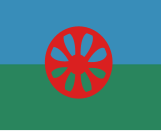
Variant seen in Romania's Călărași County

Old flag of Šuto Orizari Municipality

One of Tomáš Rafa's Romani-themed variations on the Czech flag
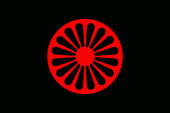
Romani anarchist flag
Notes[]
- ^ Heinrich von Wlislocki, Vom wandernden Zigeunervolke: Bilder aus dem Leben der Siebenbürger Zigeuner, p. 14. Hamburg: Aktien-Gesellschaft, 1890
- ^ J. G. F. Pflueger, Geschichte der Stadt Pforzheim, pp. 184–185. Pforzheim: J. M. Flammer, 1862
- ^ Elena Marushiakova, Veselin Popov, "Commencement of Roma Civic Emancipation", in Studies in Arts and Humanities, Vol. 3, Issue 2, 2017, p. 12
- ^ Marushiakova & Popov (2021), pp. 29, 304
- ^ Marushiakova & Popov (2021), p. 134
- ^ Marushiakova & Popov (2018), pp. 387–388
- ^ Klímová-Alexander, p. 202
- ^ Marushiakova & Popov (2021), pp. 463–464. See also Marushiakova & Popov (2018), p. 394
- ^ Liégeois (1995), p. 39
- ^ a b c d e f g h i j k Whitney Smith, "The Ensignment of the Romani People", in Proceedings of the 22nd International Congress of Vexillology, 2007, [n. p.]
- ^ Marushiakova & Popov (2021), pp. 364, 463
- ^ Klímová-Alexander, p. 170; Marushiakova & Popov (2018), p. 394. See also Marushiakova & Popov (2021), p. 364
- ^ Klímová-Alexander, pp. 176, 191, 202. See also Marushiakova & Popov (2021), pp. 370–371
- ^ Marushiakova & Popov (2021), p. 619
- ^ Marushiakova & Popov (2021), p. 642
- ^ Marushiakova & Popov (2021), p. 621
- ^ "Les funérailles du roi des bohémiens", in Journal des Débats, Vol. 149, Issue 98, April 1937, p. 2
- ^ Marushiakova & Popov (2021), pp. 624, 626
- ^ Marushiakova & Popov (2021), pp. 94, 158
- ^ Marushiakova & Popov (2021), p. 199
- ^ Marushiakova & Popov (2021), pp. 261, 263
- ^ Klímová-Alexander, p. 172
- ^ Liégeois (1974), p. 12
- ^ Nicholas Saul, Gypsies and Orientalism in German Literature and Anthropology of the Long Nineteenth Century, p. 161. London: Legenda (Modern Humanities Association), 2007. ISBN 978-1-900755-88-7
- ^ Marushiakova & Popov (2021), pp. 364–365
- ^ Marushiakova & Popov (2021), p. 465
- ^ Martin Holler, "«Comme les Juifs?» Persécution et extermination des Roms soviétiques par les nazis sous l'occupation militaire allemande. Une nouvelle interprétation fondée sur des sources soviétiques", in Catherine Coquio, Jean-Luc Poueyto (eds.), Roms, Tsiganes, Nomades: Un malentendu européen, p. 153. Paris: Editions Karthala, 2014. ISBN 978-2-8111-1123-6
- ^ Ursula Hemetek, Mozes Heinschink, "Lieder im Lied. Zu KZ-Liedern der Roma in Österreich", in Siegwald Ganglmair (ed.), Dokumentationsarchiv des österreichischen Widerstandes. Jahbuch 1992, pp. 90–91. Vienna: Documentation Centre of Austrian Resistance, 1992. ISBN 3-901142-06-1
- ^ Marushiakova & Popov (2021), pp. 110–111
- ^ Marushiakova & Popov (2021), p. 139
- ^ "Le roi des tziganes veut se démocratiser", in Le Rhône. Journal Valaisan d'Informations, Issue 35/1946, p. 3
- ^ Fr. Lang, "Trois événements vus par la presse. 3. Le premier pèlerinage du peuple nomade à Lourdes", in Études Tsiganes, Vol. 3, Issue 3, July 1957, pp. 26, 29, 31
- ^ Maurice Colinon, "Les gitans et Lourdes", in Monde Gitan, Issue 3, 1967, p. 1
- ^ Sierra, p. 282
- ^ Liégeois (1974), pp. 16, 17, 20
- ^ Liégeois (1974), pp. 15–19
- ^ Liégeois (1974), p. 16
- ^ Sierra, pp. 281–282. See also Liégeois (1974), pp. 19–20
- ^ Sierra, pp. 273–279
- ^ Liégeois (1974), p. 21
- ^ a b Kenrick, p. 89
- ^ Tony Dumas, "Fandango and the Rhetoric of Resistance in Flamenco", in Música Oral del Sur. Revista Internacional, Vol. 12, 2015, p. 535
- ^ Liégeois (1974), p. 27
- ^ François Jourda de Vaux de Foletier, "Le Pèlerinage international des Tsiganes en Belgique", in Études Tsiganes, Vol. 15, Issue 3, September 1969, p. 45 (and illustrations, p. 44)
- ^ Liégeois (1974), p. 24
- ^ Leuléa Rouda, "Un people du tiers-monde", in Droit & Liberté. Revue Mensuelle du Mouvement contre le Racisme, l'Antisémitisme et pour la Paix, Issue 262, May 1968, p. 22
- ^ Marushiakova & Popov (2018), p. 394
- ^ Marushiakova & Popov (2021), p. 463
- ^ Marushiakova & Popov (2018), p. 395
- ^ Duminică, p. 150; Trehan, p. 12
- ^ Marushiakova & Popov (2018), pp. 394–395
- ^ Duminică, p. 150; Kenrick, p. 89; Marushiakova & Popov (2018), p. 395; Trehan, p. 12. See also Balogh, pp. 149–150
- ^ Balogh, pp. 149–150
- ^ Trehan, p. 24
- ^ (in French) Dominique Garrel, Nico, "Anarcho-communiste, tsigane et peintre", in La Marseillaise, August 2, 2009
- ^ Balogh, p. 150
- ^ da Silva Mello & Berocan Veiga, p. 49
- ^ Duminică, p. 150
- ^ Balogh, p. 150
- ^ Oana Marcu, Malizie di strada. Una ricerca azione con giovani rom romeni migranti, p. 10. Milan: FrancoAngeli, 2014. ISBN 9788891715975
- ^ Balogh, p. 150
- ^ Duminică, p. 150
- ^ Philippe de Marne, "La rencontre de Lérida. 15–17 mai 1987", in Études Tsiganes, Vol. 33, Issue 2, 1987, p. 46
- ^ Elena Marushiakova, Veselin Popov, "Die führende Rolle der jugoslawischen Roma in der internationalen Szene", in Roma Geschichte 6.2: Institutionalisierung und Emanzipierung. Zusammengestellt von den Herausgebern, p. 5. Austrian Ministry of Education & Council of Europe, [n. y.]
- ^ Kenrick, pp. 296–297; Liégeois (1975), p. 18
- ^ Silverman, p. 309
- ^ M. D., "Discographie. T.E.—Djivalan Romale (Pjevajte Romi)", in Études Tsiganes, Vol. 20, Issue 4, December 1974, p. 60
- ^ François Jourda de Vaux de Foletier, "Le pèlerinage romain des Tsiganes dans le cadre de l'année sainte", in Études Tsiganes, Vol. 21, Issue 4, December 1975, p. 23
- ^ Liégeois (1975), p. 22
- ^ a b Dany Peto-Manso, "Choses vues. Paris. En mémoire des déportés", in Monde Gitan, Issue 35, 1975, p. 15
- ^ a b Jean-Pierre Quélin, "Un homme se lève", in Le Monde, October 28, 1980, p. 42
- ^ Grattan Puxon, "Yul Brynner, une figure pour l'histoire Rom", in Études Tsiganes, Vol. 32, Issue 1, January 1986, pp. 36, 38
- ^ "Echos de partout. Des kilomètres à pied", in Monde Gitan, Issue 58, 1981, p. 17
- ^ Mirian Alves de Souza, "Gypsies ou Roma? Denominadores comuns e codificação política em Toronto, Canadá", in Claudia Fonseca, Ana Lucia Pastore Schritzmeyer, Eliane Cantarino O'Dwyer, Patrice Schuch, Russell Parry Scott, Sergio Carrara (eds.), Antropologia e Direitos Humanos, Vol. 6, pp. 123–124. Rio de Janeiro: Mórula, 2016. ISBN 978-85-65679-36-7
- ^ János Báthory, "Cigány identitásformák változóban", in Vigilia, Vol. 3, 2011, p. 175
- ^ Liégeois (1995), p. 40
- ^ Željko Heimer, "National Identity in the Political Party Flags in Croatia", in Proceedings of the 24th International Congress of Vexillology, 2011, pp. 447, 465–466
- ^ (in Spanish) Santa Coloma de Gramenet, "El último viaje, rodeado de su gente", in El País, July 4, 1992
- ^ Mark Swed, "A Wondrous Violinist Who Was a True Citizen of the World", in Los Angeles Times, March 16, 1999
- ^ da Silva Mello & Berocan Veiga, passim
- ^ (in Spanish) "El Ayuntamiento recibe la bandera gitana en el día de esta etnia en Madrid", in La Vanguardia, May 24, 2018
- ^ (in Spanish) Emilio J. Martínez, "La bandera del pueblo gitano luce en el Ayuntamiento de Alicante", in eldiario.es, April 5, 2018
- ^ Aberystwyth town councillors disagree over Romany flag, BBC News, October 14, 2011
- ^ Duminică, pp. 155–162
- ^ Valerie Hopkins, Shutka: Inside Macedonia's only Roma-run municipality, Al Jazeera, April 8, 2017
- ^ Duminică, pp. 159, 161
- ^ Franco Bunčuga, Luca Vitone, "Anarchici, bandiere, Rom, identità...", in A. Rivista Anarchica, Issue 420, November 2017, pp. 78–80
- ^ Gaëlla Loiseau, "Capter l'autre. Ethnographie de l'univers connecté des gens du voyage", in Netcom (Networks and Communication Studies), Vol. 29, Issues 1–2, 2015, pp. 115, 120
- ^ Jan Richter, Artist Fined over Designs of Czech–Romany Flags, Radio Prague, January 3, 2014
- ^ Balogh, p. 150
- ^ "Roma fiatalok találkozása Ferenc pápával", in Máltai Hírek, Vol. XXI, Issue 4, December 2015, p. 9
- ^ (in Italian) Luigi Panella, "Boxe, Spada: 'Salirò sul ring con la bandiera rom, niente tricolore e inno di Mameli'", in La Repubblica, March 28, 2014
- ^ Michel Corbic, "Le drapeau jaune et la République", in Drapeaux et Pavillons. Bulletin de la Société Française de Vexillologie, Issue 141, 2019, p. 5
- ^ (in Romanian) Andreea Mitrache, "'Decât țigani, mai bine să ne zică indieni'", in Adevărul, Craiova edition, December 5, 2010
- ^ (in Romanian) Daciana Ilie, "Funeraliile lui Cioabă, fără prea mult fast, dar cu încoronarea a doi regi ai romilor", Mediafax, August 23, 2013
- ^ David Kergel, "Integration and Inclusion — Towards an Alternative 'European Gaze' on the Roma", in Peter Herrmann, Sibel Kalaycıoğlu (eds.), Precarity - More Than a Challenge of Social Security: Or: Cynicism of EU's Concept of Economic Freedom. Studies in Comparative Social Pedagogies and International Social Work and Social Policy, Vol. XVI, pp. 147–148. Bremen: Europäischer Hochschulverlag, 2011. ISBN 978-3-86741-705-1
- ^ Silverman, p. 48
- ^ J. Vekerdi, "Bibliographie. Zsolt Csalog, Kilenc cigany (Neuf Tsiganes)", in Études Tsiganes, Vol. 23, Issue 1, March 1977, pp. 33–34
- ^ Jud Nirenberg, "Romani Political Mobilization from the First International Romani Union Congress to the European Roma, Sinti and Travellers Forum", in Nando Sigona, Nidhi Trehan (eds.), Romani Politics in Contemporary Europe. Poverty, Ethnic Mobilization, and the Neoliberal Order, pp. 99–100. Houndmills & New York: Palgrave Macmillan, 2009. ISBN 978-0-230-51662-5
- ^ Caterina Pasqualino, "Politique, catholicisme et évangélisme. Les Gitans d'Estrémadure (Espagne)", in Gradhiva. Rrevue d'Histoire et d'Archives de l'Anthropologie , Issue 32, 2002, p. 41
- ^ Rubin Zemon, "Istorija Identiteta Aškalija", in Istorija balkanskih Egipćana i Aškalija, pp. 2–3. Council of Europe, [n. y.]
- ^ Scott Millar, "Travellers flag up their desire for official status", in The Sunday Times, January 11, 2004
- ^ Eoin English, "Traveller flag flies over Cork City Hall", in Irish Examiner, June 6, 2018
References[]
- Lídia Balogh, "Esztétikum közcélra. A szimbólumok, mítoszok, illetve allegóriák közösségi szerepéről, a roma nemzetépítési törekvések példáján keresztül", in Pro Minoritate, Vol. 3, 2011, pp. 144–157.
- Marco Antonio da Silva Mello, Felipe Berocan Veiga, "Le «Jour national du Tsigane» au Brésil. Espaces symboliques, stéréotypes et conflits autour d'un nouveau rite du calendrier officiel", in Brésil(s). Sciences Humaines et Sociales, Vol. 2, 2012, pp. 41–78.
- Ion Duminică, "Simbolistica tradițională a romilor europeni în perioada contemporană (I)", in Buletinul Științific al Muzeului Național de Etnografie și Istorie Naturală a Moldovei, Vol. 11, 2009, pp. 149–163.
- Donald Kenrick, The A to Z of the Gypsies (Romanies). Lanham: Rowman & Littlefield, 2007. ISBN 978-0-8108-7561-6
- Ilona Klímová-Alexander, "The Development and Institutionalization of Romani Representation and Administration, Part 2. Beginnings of Modern Institutionalization (Nineteenth Century—World War II)", in Nationalities Papers, Vol. 33, Issue 2, June 2005, pp. 155–210.
- Jean-Pierre Liégeois,
- "Le règne de l'utopie", in Études Tsiganes, Vol. 20, Issues 2–3, September 1974, pp. 10–31.
- "Le pouvoir tsigane", in Études Tsiganes, Vol. 21, Issue 1, March 1975, pp. 6–33.
- "L'émergence internationale du mouvement politique rom", in Hommes & Migrations, Issues 1188–1189, June–July 1995, pp. 38–44.
- Elena Marushiakova, Veselin Popov,
- "Roma Labelling: Policy and Academia", in Slovenský Národopis, Vol. 66, Issue 4, 2018, pp. 385–418.
- Roma Voices in History: A Sourcebook. Roma Civic Emancipation in Central, South-Eastern and Eastern Europe from the 19th Century until World War II. Paderborn: Brill Publishers, 2021. ISBN 978-3-506-70518-1
- María Sierra, "Creating Romanestan: A Place to be a Gypsy in Post-Nazi Europe", in European History Quarterly, Vol. 49, Issue 2, April 2019, pp. 272–292.
- Carol Silverman, Romani Routes: Cultural Politics and Balkan Music in Diaspora. Oxford etc.: Oxford University Press, 2011. ISBN 978-0-19-530094-9
- Nidhi Trehan, "The Contentious Politics of the Indo-Romani Relationship. Reflections on the 'International Roma Conference and Cultural Festival' in New Delhi, February 2016 and Its Antecedents", in The Indian Journal of Social Work, Vol. 78, Issue 1, January 2017, pp. 11–25.
External links[]
- Romani flag, Flags of the World entry
- Romani culture
- Ethnic flags
- Flags introduced in 1971







